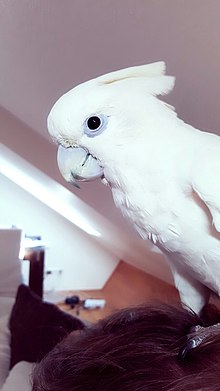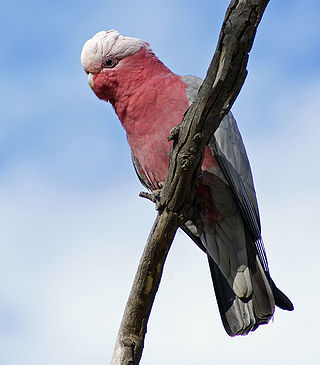
A cockatoo is any of the 21 species of parrots belonging to the family Cacatuidae, the only family in the superfamily Cacatuoidea. Along with the Psittacoidea and the Strigopoidea, they make up the order Psittaciformes. The family has a mainly Australasian distribution, ranging from the Philippines and the eastern Indonesian islands of Wallacea to New Guinea, the Solomon Islands and Australia.
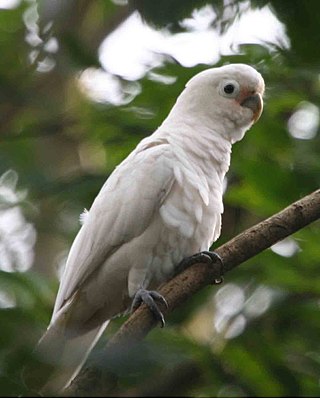
The Tanimbar corella, also known as Goffin's cockatoo or Tanimbar cockatoo, is a species of cockatoo endemic to forests of Yamdena, Larat and Selaru, all islands in the Tanimbar Islands archipelago in Indonesia. It has been introduced to the Kai Islands, Indonesia, Puerto Rico and Singapore. This species was only formally described in 2004, after it was discovered that the previous formal descriptions pertained to individuals of a different cockatoo species, the Ducorps' or Solomons cockatoo. Tanimbar corellas are the smallest of the white cockatoos. It is classified as Near Threatened due to deforestation and bird trade. It breeds well in captivity and there is a large avicultural population.

The pink cockatoo, also known as the Major Mitchell's cockatoo or the Leadbeater's cockatoo, is a medium-sized cockatoo that inhabits arid and semi-arid inland areas of Australia, though it is seen regularly in other climates, for example, South-East Queensland's subtropical region.

The salmon-crested cockatoo, also known as the Moluccan cockatoo, is a cockatoo endemic to the Seram archipelago in eastern Indonesia. At a height of up to 46–52 centimetres (1.51–1.71 ft) and weight of up to 850 grams (1.87 lb), it is among the largest of the white cockatoos. The female is slightly smaller than the male on average. It has white-pink feathers with a definite peachy glow, a slight yellow on the underwing and underside of the tail feathers and a large retractable recumbent crest which it raises when threatened, revealing hitherto concealed bright red-orange plumes to frighten potential attackers. It may also be raised in excitement or in other 'emotional' displays. Some describe the crest as "flamingo-colored". It also has one of the louder calls in the parrot world and in captivity is a capable mimic.

The galah, less commonly known as the pink and grey cockatoo or rose-breasted cockatoo, is an Australian species of cockatoo and the only member of the genus Eolophus. The galah is adapted to a wide variety of modified and unmodified habitats and is one of Australia's most abundant and widespread bird species. The species is endemic to mainland Australia. It was introduced to Tasmania, where it is now widespread, in the mid-19th century and much more recently to New Zealand.

The white cockatoo, also known as the umbrella cockatoo, is a medium-sized all-white cockatoo endemic to tropical rainforest on islands of Indonesia. When surprised, it extends a large and striking head crest, which has a semicircular shape. The wings and tail have a pale yellow or lemon color which is exposed when they fly. It is similar to other species of white cockatoo such as yellow-crested cockatoo, sulphur-crested cockatoo, and salmon-crested cockatoo, all of which have yellow, orange or pink crest feathers instead of white.
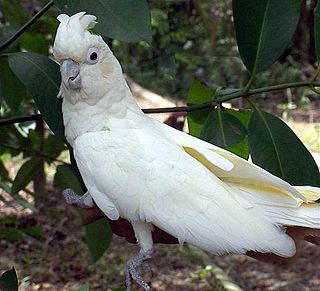
The red-vented cockatoo, also known as the Philippine cockatoo and locally katala, abukay, agay or kalangay, is a species of cockatoo. It is endemic to the Philippines. Though pressured by environmental degradation and illegal pet trades, the population of the Philippine cockatoo is somehow growing owing to the Katala Organization. It is roughly the size and shape of the Tanimbar corella, but is easily distinguished by the red feathers around the vent. It is threatened by habitat loss and the cage-bird trade.

The long-billed corella, also known as long-billed cockatoo or slender-billed corella, is a cockatoo native to Australia, which is similar in appearance to the little corella. This species is mostly white, with a reddish-pink face and forehead, and has a long, pale beak, which is used to dig for roots and seeds. It has reddish-pink feathers on the breast and belly.

The sulphur-crested cockatoo is a relatively large white cockatoo found in wooded habitats in Australia, New Guinea, and some of the islands of Indonesia. They can be locally very numerous, leading to them sometimes being considered pests. A highly intelligent bird, they are well known in aviculture, although they can be demanding pets.

The yellow-crested cockatoo also known as the lesser sulphur-crested cockatoo, is a medium-sized cockatoo with white plumage, bluish-white bare orbital skin, grey feet, a black bill, and a retractile yellow or orange crest. The sexes are similar.

The little corella, also known as the short-billed corella, bare-eyed cockatoo, blood-stained cockatoo, and little cockatoo is a white cockatoo native to Australia and southern New Guinea. It was known as Birdirra among the Yindjibarndi people of the central and western Pilbara. They would keep them as pets, or traditionally cook and eat them. The downy feathers are used in traditional ceremonies and dances where they adorn head and armbands.

Eclectus is a genus of parrot, the Psittaciformes, which consists of four known extant species known as eclectus parrots and the extinct Eclectus infectus, the oceanic eclectus parrot. The extant eclectus parrots are medium-sized parrots native to regions of Oceania, particularly New Guinea and Australia. Males are mostly bright green, females are predominantly bright red. The male and female eclectus were once thought to be different species. The conservation status of the remaining species is least concern. Eclectus parrots do well in captivity, and are a very popular pet across the world.

The blue-eyed cockatoo is a large, mainly white cockatoo about 50 cm (20 in) long with a mobile crest, a black beak, and a light blue rim of featherless skin around each eye that gives this species its name.

The western corella also known as the western long-billed corella, is a species of white cockatoo endemic to south-western Australia.

The uniform swiftlet,, also known as the Vanikoro swiftlet or lowland swiftlet, is a gregarious, medium-sized swiftlet with a shallowly forked tail. The colouring is dark grey-brown, darker on the upperparts with somewhat paler underparts, especially on chin and throat. This species is widespread from the Philippines through Wallacea, New Guinea and Melanesia. It forages for flying insects primarily in lowland forests and open areas. It nests in caves where it uses its sense of echolocation, rare in birds, to navigate.
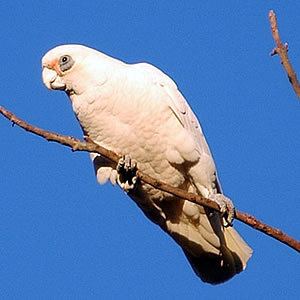
Licmetis is a subgenus of the white cockatoos. They are collectively known as corellas in Australia. Three of the six species are primarily – or only – found in Australia, while the Philippines, Indonesia, and the Solomons each have an endemic species. They are relatively small cockatoos and – unlike the members of the subgenus Cacatua – all have pale bills. While most show yellow-tinged underwings and some red to the face, none has conspicuously coloured crests.

The duchess lorikeet is a species of parrot in the family Psittaculidae. It is the only species placed in the genus Charmosynoides. It is found throughout the Solomon Islands archipelago. Its natural habitats are subtropical or tropical moist lowland forest, subtropical or tropical moist montane forest, and plantations. It is threatened by habitat loss.

The Eleonora cockatoo, Cacatua galerita eleonora, also known as medium sulphur-crested cockatoo, is a subspecies of the sulphur-crested cockatoo. It is native to the Aru Islands in the province of Maluku in eastern Indonesia, but has also been introduced to Kai Islands. Avicultural populations are well-established in Europe and the United States.
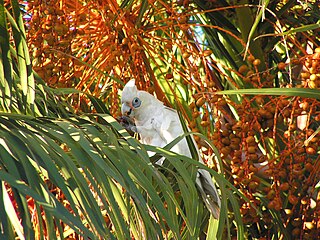
Muir's corella is a stocky, medium-sized white cockatoo endemic to Western Australia. It was the threatened nominate subspecies of the western corella. It was removed from the WA's threatened species list in November 2012 as a result of successful conservation efforts.

The Triton cockatoo is one of the four subspecies of the sulphur-crested cockatoo. The cockatoo was first described by Dutch zoologist, Coenraad Jacob Temminck, in 1849. There is no documentation as to why Temminck selected this name however it is suggested that it was named after the Dutch corvette, Triton, which operated off the Dutch New Guinea coastline, in 19th century.
